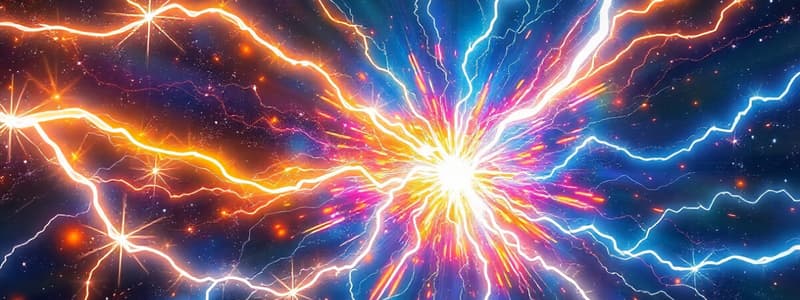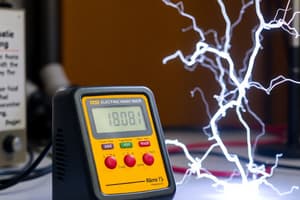Podcast
Questions and Answers
What is the standard unit of current?
What is the standard unit of current?
- Ampere (correct)
- Volt
- Coulomb
- Ohm
Which type of current has a constant flow of electrons in one direction?
Which type of current has a constant flow of electrons in one direction?
- Pulsating Current
- Direct Current (DC) (correct)
- Alternating Current (AC)
- Reactive Current
What does higher resistance at the same voltage result in?
What does higher resistance at the same voltage result in?
- Inconsistent current
- Lower current (correct)
- No change in current
- Higher current
What device is used to convert alternating current (AC) to direct current (DC)?
What device is used to convert alternating current (AC) to direct current (DC)?
What is voltage a measure of?
What is voltage a measure of?
What is the unit of electric charge?
What is the unit of electric charge?
Which particles inside the atom are responsible for electric charge?
Which particles inside the atom are responsible for electric charge?
What does the law of electric charges state?
What does the law of electric charges state?
What type of charge is present when an object has an equal number of protons and electrons?
What type of charge is present when an object has an equal number of protons and electrons?
How does distance affect the strength of the electric force?
How does distance affect the strength of the electric force?
What is the process called when two objects are rubbed together leading to a charge transfer?
What is the process called when two objects are rubbed together leading to a charge transfer?
What device is used to measure whether an object is charged?
What device is used to measure whether an object is charged?
Which method of charging involves bringing a charged object near a neutral object without direct contact?
Which method of charging involves bringing a charged object near a neutral object without direct contact?
What causes the hair to stand up when holding a charged balloon near it?
What causes the hair to stand up when holding a charged balloon near it?
What is the term for the sudden flow of charges that can occur after building up static electricity?
What is the term for the sudden flow of charges that can occur after building up static electricity?
Which of the following materials is considered a good conductor of electricity?
Which of the following materials is considered a good conductor of electricity?
What role do lightning rods serve during a storm?
What role do lightning rods serve during a storm?
What happens during the process of creating an electromagnet?
What happens during the process of creating an electromagnet?
Which of the following is an example of an insulator?
Which of the following is an example of an insulator?
Which factor contributes to making a material a good insulator?
Which factor contributes to making a material a good insulator?
How does static electricity relate to magnetism?
How does static electricity relate to magnetism?
Flashcards
Atom
Atom
The smallest unit of matter, composed of protons, neutrons, and electrons.
Electric Charge
Electric Charge
A property of matter that creates electromagnetic interactions between atoms.
Coulomb (C)
Coulomb (C)
The unit of measurement for electric charge.
Electric Field
Electric Field
Signup and view all the flashcards
Electric Force
Electric Force
Signup and view all the flashcards
Charging by Friction
Charging by Friction
Signup and view all the flashcards
Charging by Contact or Conduction
Charging by Contact or Conduction
Signup and view all the flashcards
Charging by Induction
Charging by Induction
Signup and view all the flashcards
Electric Current
Electric Current
Signup and view all the flashcards
Ampere (A)
Ampere (A)
Signup and view all the flashcards
Voltage
Voltage
Signup and view all the flashcards
Resistance
Resistance
Signup and view all the flashcards
Alternating Current (AC)
Alternating Current (AC)
Signup and view all the flashcards
Electric Discharge
Electric Discharge
Signup and view all the flashcards
Conductor
Conductor
Signup and view all the flashcards
Insulator
Insulator
Signup and view all the flashcards
Semiconductor
Semiconductor
Signup and view all the flashcards
Electromagnet
Electromagnet
Signup and view all the flashcards
Negatively Charged
Negatively Charged
Signup and view all the flashcards
Positively Charged
Positively Charged
Signup and view all the flashcards
Electrostatic Attraction
Electrostatic Attraction
Signup and view all the flashcards
Study Notes
Electric Charges
- Electric charges are a physical property causing electromagnetic interactions between atoms.
- The unit of electric charge is the Coulomb (C).
- Matter is composed of atoms, which contain subatomic particles: protons (+), neutrons (neutral), and electrons (-).
- Atoms are neutral because the number of protons equals the number of electrons.
- Objects can have three types of charges: positive (+), negative (-), or neutral.
Laws of Electric Charges
- Like charges repel each other.
- Unlike charges attract each other.
- Charges are neither created nor destroyed, only transferred.
- The electric field surrounds a charged object, exerting a force on other charged objects.
Electric Force
- The electric force is the attraction or repulsion between charged objects.
- The strength of the electric force depends on the type and size of the charges and the distance between them.
- A smaller distance results in a stronger force.
Charging Methods
- Friction: Rubbing objects together transfers electrons.
- Conduction: Transferring charges by direct contact.
- Induction: Rearranging charges in an object by bringing a charged object nearby without contact.
Static Electricity
- Static electricity is the buildup of electric charges.
- Static means stationary or constant.
- Examples include:
- Rubbing a balloon on hair, causing electrons to transfer
- Electric shocks after shuffling on carpet
- Lightning
Static Discharge
- Electric discharge is the sudden flow of electric charges.
- It occurs when charges build up and then quickly move to equalize.
- Examples include: touching a metal after shuffling on carpet, lightning. -Three things you notice: shock, flash, and noise (or lightening for bigger examples.)
Conductors and Insulators
- Conductors allow charges to flow easily.
- Examples: metals, water (with dissolved salts), graphite (in pencils)
- Human body can conduct small amounts of electric current.
- Insulators resist the flow of charges.
- Examples: rubber, glass, plastic, wood, paper
Electric Current
- Current (I) is the flow of electric charge or the flow of electrons through a wire.
- The unit is Ampere (A).
- Alternating current (AC) changes direction and is used in power lines and appliances.
- Direct current (DC) flows in one direction and is used in batteries.
- AC can be converted to DC using a transformer.
Factors Affecting Electric Current (Voltage and Resistance)
- Voltage (V): The difference in electrical potential driving charges.
- Higher voltage leads to a higher rate of charge flow.
- Resistance (Ω, ohms): The opposition to charge flow. Higher resistance results in lower current.
Electromagnetism
- Electricity can produce magnetism.
- Magnetism can create electricity, using electromagnets and electromagnetism.
Studying That Suits You
Use AI to generate personalized quizzes and flashcards to suit your learning preferences.




